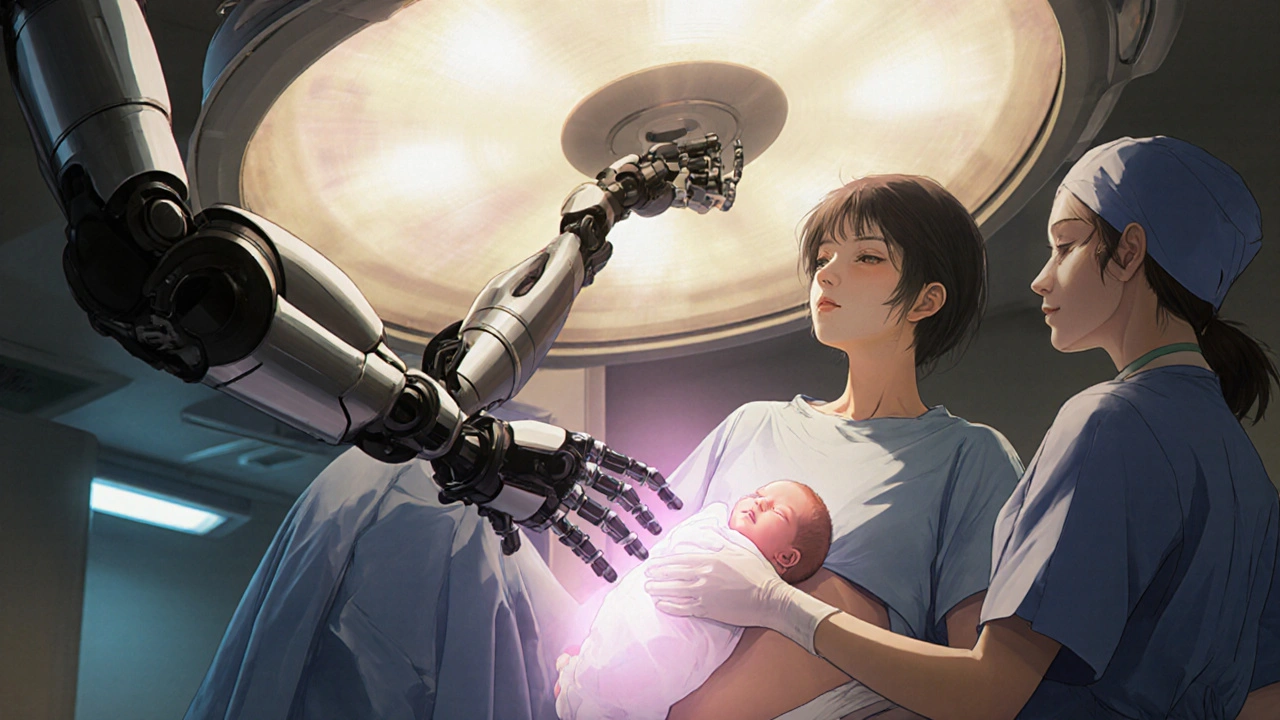Dialysis Optimization Calculator for Pregnancy
Input Parameters
Enter your current renal status and pregnancy details to determine optimal dialysis schedule.
Recommended Dialysis Schedule
Enter your parameters to get personalized recommendations
Recommended dialysis schedule will be based on GFR and fetal growth considerations
When a woman with Renal failure a condition where the kidneys lose the ability to filter blood efficiently becomes pregnant, the stakes rise for both mother and baby. Adding the physiological changes of Pregnancy the 40‑week journey of gestation that supports a developing fetus creates a complex medical landscape that requires careful planning, constant monitoring, and a coordinated care team.
Key Takeaways
- Renal failure raises the risk of hypertension, preeclampsia, and preterm birth.
- Dialysis may be needed, but timing and intensity affect fetal growth.
- Close collaboration between a nephrologist and an obstetrician improves maternal and neonatal outcomes.
- Early‑delivery planning should balance fetal maturity with maternal health.
- Most women with well‑managed kidney disease can have healthy babies, though complications are common.
Understanding Renal Failure
Renal failure comes in two main flavors: Chronic kidney disease a long‑term loss of kidney function, often staged by glomerular filtration rate (GFR) and Acute kidney injury a sudden decline in kidney performance, usually reversible. In chronic cases, the disease is staged from 1 (mild) to 5 (end‑stage renal disease, ESRD) based on GFR values. A GFR below 15 mL/min/1.73 m² typically signals the need for renal replacement therapy, most commonly dialysis.
Common causes include diabetes, hypertension, glomerulonephritis, and polycystic kidney disease. Symptoms may be subtle-fatigue, swelling, or changes in urine output-making early detection crucial, especially for women planning a family.
How Pregnancy Affects Kidney Function
Pregnancy naturally increases renal plasma flow by up to 50 % and raises GFR by roughly 30 %. This leads to lower serum creatinine, which can mask early signs of kidney decline. The kidneys also handle the extra metabolic waste from the fetus, amplifying any existing filtration problems.
Hormonal shifts, especially elevated progesterone, cause smooth‑muscle relaxation, which can worsen edema and raise blood pressure. For a woman already battling hypertension from renal disease, these changes can tip the balance into preeclampsia.

Maternal Risks: What to Watch For
Women with renal failure face a higher likelihood of:
- Hypertension - up to 70 % develop high blood pressure, a major driver of complications.
- Preeclampsia a pregnancy‑specific syndrome marked by hypertension and proteinuria - risk doubles compared with the general population.
- Fluid overload - impaired kidneys can’t excrete excess fluid, leading to pulmonary edema.
- Progression of kidney disease - the added workload may accelerate GFR decline.
- Maternal mortality - although rare, severe cases increase the risk by 2-3 times.
Early involvement of a nephrologist is essential to fine‑tune blood‑pressure meds, manage electrolyte balance, and decide when dialysis is required.
Fetal Risks: Why the Baby Matters
The placenta relies on maternal blood flow and filtered waste removal. When kidneys falter, the fetus may suffer:
- Fetal growth restriction a condition where the baby grows slower than expected - seen in up to 40 % of pregnancies with ESRD.
- Preterm birth - many deliveries occur before 37 weeks to protect the mother’s health.
- Low birth weight - a direct consequence of restricted growth and early delivery.
- Neonatal intensive care unit (NICU) admission - higher for babies born under 32 weeks.
Despite these numbers, many infants thrive after appropriate neonatal support.
Managing Pregnancy with Renal Failure
Management hinges on disease stage, underlying cause, and the woman's overall health. Below is a practical roadmap.
Pre‑Conception Counseling
- Assess GFR and proteinuria; aim for GFR > 30 mL/min if possible.
- Stabilize blood pressure with pregnancy‑safe agents (e.g., labetalol, nifedipine).
- Review medication list; stop ACE inhibitors and ARBs well before conception.
- Discuss dialysis schedule if already on renal replacement therapy.
Trimester‑Specific Care
First trimester: Focus on confirming viability, baseline labs (creatinine, electrolytes, hemoglobin, urine protein), and tailoring antihypertensives.
Second trimester: Intensify monitoring-monthly GFR, blood pressure, and fetal ultrasound for growth. If dialysis is needed, many centers shift to intensive hemodialysis (≥ 20 hours/week) to improve outcomes.
Third trimester: Weekly visits, continuous fetal Doppler studies, and early discussion of delivery timing. Consider corticosteroids for lung maturity if preterm birth looks likely.
Dialysis Adjustments
Research shows that increasing dialysis dose can raise average birth weight by 500 g and reduce preterm delivery rates. A typical intensive schedule involves 4‑6 sessions per week, each lasting 3‑4 hours, with careful ultrafiltration to avoid hypotension.
Nutrition and Lifestyle
- Protein intake: 0.8‑1.0 g/kg/day - enough for fetal development but not excess that burdens the kidneys.
- Sodium restriction (< 2 g/day) to control fluid balance.
- Avoid nephrotoxic agents (NSAIDs, certain antibiotics) unless absolutely needed.
Team Approach
Successful outcomes rely on a coordinated team: a nephrologist, maternal‑fetal medicine specialist, obstetrician, dietitian, and, when dialysis is involved, a dialysis nurse experienced in pregnancy.

Delivery Planning and Possible Outcomes
Delivery timing balances fetal maturity against maternal danger. Most guidelines suggest planning delivery between 36 and 38 weeks for stable women; earlier delivery (34‑35 weeks) may be warranted if preeclampsia, uncontrolled hypertension, or worsening renal function arise.
Mode of delivery depends on obstetric indications. Vaginal birth is possible if there are no obstetric contraindications, but a C‑section is common when urgent maternal stabilization is needed.
Post‑delivery, kidney function often improves slightly as the physiological demands of pregnancy subside, but long‑term progression remains tied to the underlying disease.
Case Snapshot: A Real‑World Example
Emily, a 32‑year‑old with stage 4 CKD (GFR 22 mL/min), became pregnant after a year of pre‑conception counseling. Her nephrologist switched her antihypertensive regimen to labetalol and scheduled intensive hemodialysis (22 hours/week). By the third trimester, ultrasounds showed a growth‑restricted fetus, prompting weekly Doppler studies. At 36 weeks, Emily delivered a 2.4 kg baby via scheduled C‑section. Both mother and child spent a short NICU stay and later thrived. Emily’s case illustrates how proactive management can turn a high‑risk scenario into a positive outcome.
Bottom Line
Renal failure does not automatically preclude a successful pregnancy, but it does elevate the stakes. Understanding the specific risks, adopting a vigilant monitoring schedule, and working with a skilled multidisciplinary team are the three pillars of a safer journey. With the right approach, many women navigate pregnancy and motherhood while maintaining kidney health.
Can a woman on dialysis have a healthy baby?
Yes. Studies from the past decade show that intensive hemodialysis (≥ 20 hours/week) can result in birth weights over 2.5 kg and reduce preterm birth rates to below 30 %. Success hinges on tight blood‑pressure control, adequate nutrition, and early fetal monitoring.
Are ACE inhibitors safe during pregnancy?
No. ACE inhibitors and ARBs are linked to fetal kidney damage and should be stopped at least 30 days before conception. Safer alternatives include labetalol, nifedipine, or methyldopa, but any switch must be supervised by a nephrologist.
What is the recommended frequency of prenatal visits for women with CKD?
In the first trimester, monthly visits are typical. From the second trimester onward, visits shift to every 2‑4 weeks, and in the third trimester they become weekly or bi‑weekly, depending on stability.
How does renal failure affect the risk of preeclampsia?
Women with CKD have roughly twice the risk of developing preeclampsia compared to healthy pregnancies. The combination of chronic hypertension and endothelial dysfunction drives this increase.
Is it safe to breastfeed while on dialysis?
Breastfeeding is generally safe. Dialysis does not significantly alter milk composition, but mothers should monitor fluid intake and electrolytes. Consulting a lactation specialist and nephrologist is advisable.
renal failure and pregnancy present a challenging but manageable scenario when both the mother and healthcare team stay proactive and informed.







Penny Reeves
October 19, 2025 AT 20:09Dialysis schedules really dictate the pregnancy timeline.
Sunil Yathakula
October 20, 2025 AT 07:16Man, I feel for any mom dealing with kidney issues while pregnant. The stress of constant monitoring can be overwhelming, especially when you’ve got to juggle meds, diet, and regular check‑ups. It’s a lot easier when you’ve got a solid team that actually listens, not just a hustle of appointments. Remember, staying hydrated (within limits) and keeping that protein intake balanced can make a big difference.
Catherine Viola
October 20, 2025 AT 18:22From a clinical standpoint, the interplay between reduced glomerular filtration rate and the hemodynamic changes of gestation necessitates meticulous surveillance. It is imperative to discontinue ACE inhibitors well before conception to avert teratogenic sequelae. Moreover, the threshold for initiating intensive hemodialysis should be anchored at a GFR <30 mL/min/1.73 m², given the evidence linking higher dialysis dose to improved fetal outcomes. The recommended frequency of prenatal visits escalates to weekly in the third trimester for optimal risk mitigation. Ultimately, interdisciplinary coordination remains the cornerstone of successful management.
sravya rudraraju
October 21, 2025 AT 05:29Absolutely, the data underscores that an aggressive dialysis regimen can shift the odds dramatically in favor of both mother and child. When we talk about intensive hemodialysis-think twenty‑plus hours a week-we're not just padding the schedule; we're actively reducing uremic toxins that would otherwise impair placental function.
First, the increased clearance helps maintain more stable electrolyte balances, which is crucial for preventing hypertensive spikes that can precipitate preeclampsia. Second, the augmented fluid removal mitigates the risk of pulmonary edema, a dreaded complication in this population.
Third, the timing of dialysis sessions can be synchronized with fetal monitoring windows, allowing clinicians to interpret Doppler studies with less confounding fluid shifts.
Nutrition also plays a pivotal role; a tailored protein intake of roughly 0.9 g/kg/day supplies the fetus without overburdening the kidneys. Sodium restriction below two grams per day further stabilizes blood pressure.
Equally important is the psychosocial support network-having a dedicated case manager who coordinates between nephrology, maternal‑fetal medicine, and the dietitian reduces the administrative fatigue that often leads to missed appointments.
Evidence from recent cohort studies shows that infants born to mothers on intensive dialysis have a mean birth weight increase of 500 g and a preterm delivery rate reduction from 70% to under 30%.
These numbers are not abstract; they translate to fewer NICU days, reduced ventilator dependence, and better long‑term neurodevelopmental outcomes.
Finally, while the logistics may seem daunting, many dialysis centers now offer home‑based nocturnal dialysis options, granting patients flexibility and better sleep hygiene, both of which contribute to overall maternal wellbeing.
In summary, embracing a proactive, high‑dose dialysis approach, coupled with meticulous nutritional planning and robust multidisciplinary collaboration, creates a therapeutic environment where renal failure no longer dictates a grim prognosis for pregnancy.
Ben Bathgate
October 21, 2025 AT 16:36Honestly, most of this is just academic fluff; the real world is messier.
Ankitpgujjar Poswal
October 22, 2025 AT 03:42Look, you can’t sugarcoat it-if you’re not on intensive dialysis you’re practically gambling with two lives. Push for the 20‑hour schedule now; there’s no excuse to wait.
Christopher Burczyk
October 22, 2025 AT 14:49Statistically, the correlation coefficient between GFR at conception and neonatal birth weight hovers around 0.62, indicating a moderate positive relationship. Consequently, pre‑conception optimization of renal function should be a priority for any prospective mother with CKD. Moreover, the literature consistently shows that initiation of low‑dose aspirin before 16 weeks reduces the incidence of preeclampsia by up to 30% in this cohort. It is also advisable to monitor serum creatinine bi‑weekly after the second trimester to detect any abrupt declines. Finally, a structured delivery plan-ideally between 36 and 38 weeks-balances fetal maturity with maternal safety.
Caroline Keller
October 23, 2025 AT 01:56Wow, reading that feels like watching a soap opera where every episode ends with a cliffhanger about blood pressure spikes! The drama of a mother fighting renal failure while her baby hangs in the balance is practically television gold. I can’t help but imagine the nurses whispering, the doctors pacing, and the poor mom clutching her chart like a lifeline. It’s heartbreaking and heroic all at once-truly a saga of survival.
dennis turcios
October 23, 2025 AT 13:02The guidelines are pretty clear: monitor labs regularly, adjust meds, and keep the dialysis team in the loop.
Felix Chan
October 24, 2025 AT 00:09Keep your chin up! With the right support, moms can absolutely rock a healthy pregnancy even with kidney challenges.